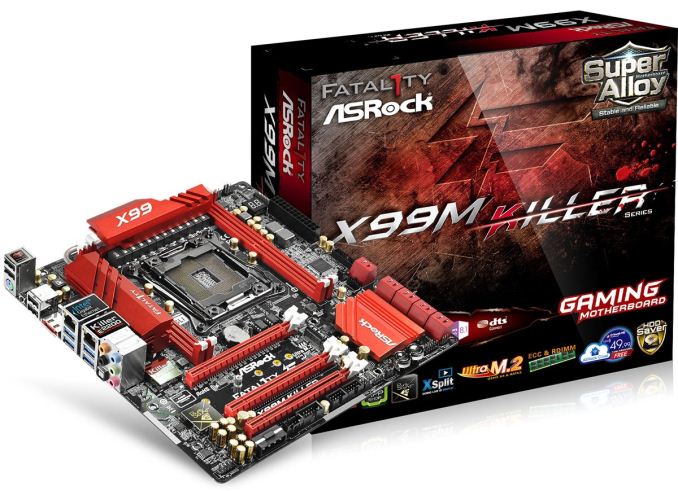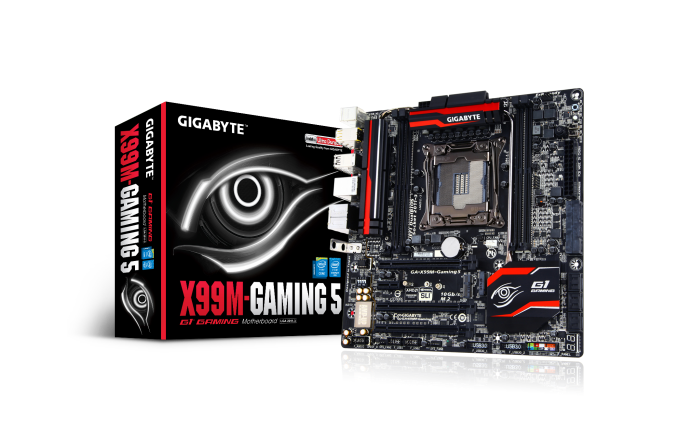Best X99 Motherboards: Holiday 2014
by Ian Cutress on November 27, 2014 8:00 AM EST- Posted in
- Motherboards
- MSI
- Gigabyte
- ASRock
- EVGA
- Asus
- ATX
- X99
- mATX
- Holiday 2014
X99 in microATX
There is something about having as much localized compute power in as small a form factor as possible that excites me. Aside from investing in a full sever rack, the best 1P system under the desk scenarios involve Haswell-E in a custom form factor from one of the big system integrators. For home builds, we are limited to micro-ATX, perhaps for good reason. Two of the main selling points of Haswell-E are the 40 PCIe lanes from the CPU and quad channel memory. Mini-ITX sized motherboards would only have access to one PCIe 3.0 x16 slot and might have to be reduced down to dual channel memory due to the size of the socket. As a result micro-ATX remains the home build standard for small form factor Haswell-E.
Despite this potential market, the motherboard manufacturers tend to stay away from this market. At present there are only three motherboards to choose from with another incoming soon, all of which are on the cheaper end of X99 at under $270. We have three of the four in for review, already partially tested, so here is a quick overview.
EVGA X99 Micro, $250
Historically EVGA creates two or three motherboard per chipset, focusing on the form factors it feels are focused on gaming. So alongside the full sized X99 Classified and X99 SLI they have released the X99 Micro. Because EVGA is a smaller company than the big four, their purchasing power for controller ICs is perhaps not the best, but EVGA's philosophy of bringing all hardware issues in house for repair and replacement is one of the reasons for their strong following.
The X99 Micro's first feature to notice is the cover over the rear panel, giving the aesthetic a cleaner and sleeker look.
Similar to the X99M Killer, we have one DIMM per channel memory, but the PCIe lane allocation splits from x16/x16 to x8/x8/x8 for three PCIe devices and the latter is only available with a 40 PCIe lane CPU (all except the i7 5820K). The Micro uses only six of the SATA ports, presumably being the RAID capable ones but it seems a little odd not to include the other four. We do get a slick PCB, power/reset buttons, audio via a Realtek ALC1150 and an Intel I217-V network interface. M.2 is also supported via a PCIe 2.0 x2 arrangement from the PCH.
ASRock Fatal1ty X99M Killer, $250
The sole gaming focused motherboard in this segment comes from ASRock's line of Fatal1ty motherboards, sporting a red theme and focusing on the Qualcomm Atheros Killer network controller to provide the naming. ASRock equips the motherboard with its gaming variants of the BIOS and software, including the mouse polling port and network prioritization.
For connectivity we get the full set of 10 SATA ports from the chipset along with eight USB 3.0 ports and an improved Realtek ALC1150 audio solution. Networking comes from the Killer NIC along with an Intel one for good measure.
Much like the EVGA model, one of the major draws to this motherboard will be the styling, but thankfully Fatal1ty's face no longer adorns the BIOS in the Killer range. The X99M Killer comes in at $250 and supports x16/x16 for dual GPU, although the other slot is only PCIe 2.0 x4 via the chipset, limiting three-way configurations. It is also worth noting that in order to use three PCIe devices, you need to have single slot devices such as low end GPUs, Quadro and FirePro cards. When using an i7-5820K, due to having only 28 PCIe lanes, the lane allocation drops to x16/x8.
GIGABYTE X99M-Gaming 5, $270
A relative newcomer to the mATX X99 market, this model extends GIGABYTE’s gaming line with the characteristic G1.Gaming styling. One of the main features on this motherboard is the PCIe arrangement, offering a x16/x16/x8 layout with 40 PCIe lane CPUs (x16/x8/x4 for the i7-5820K) affording a good amount of PCIe bandwidth for single-slot professional level co-processors.
Aside from the heatpipes connecting all the heatsinks, the X99M-Gaming 5 supports both SATA Express and M.2 x2 as well as the full set of SATA 6 Gbps ports from the PCH. Elements of GIGABYTE’s design come from the improved Realtek ALC1150 package, offering an EM shield, filter caps, PCB separation and an upgradeable OP-AMP. The rear panel also has four USB.DAC-UP ports for a cleaner 5V power delivery. There is space for an M.2 x1 WiFi module, although this should be purchased separately. GIGABYTE also likes to point out its power delivery design, featuring PowIRStage ICs and server level chokes.
ASRock X99M Extreme4, $231
One of the cheapest X99 motherboards on sale at the time of writing is the ASRock X99M Extreme4, competing against the X99-UD3 and the X99S SLI PLUS. Similar to the X99M Killer, all 10 SATA 6 Gbps are being used although we are limited to one DIMM per channel due to the size of the motherboard. The PCIe layout is also x16/x16 (x16/x8 with i7-5820K) with another PCIe 2.0 x4 from the PCH for a third slot.
Aside from the Killer NIC becoming an Intel, it would seem from the outset that not much changes from the Killer to the Extreme4 micro-ATX models. The software and BIOS for the Extreme4 are the regular ASRock affair rather than the gaming additions, and also we lose the faster polling mouse port, however there is still the upgraded ALC1150 audio and the PCIe 3.0 x4 M.2 slot between the PCIe slots. For a $20 difference between the X99M Killer and the X99M Extreme4, it all comes down to the value of the Killer NIC and the gaming oriented software.
As mentioned, we have these three motherboards in for review and hope to get to them before the turn of the year. Stay tuned for those.




















_thumb.jpg)
_thumb.jpg)
_thumb.jpg)
_thumb.jpg)
_thumb.jpg)








15 Comments
View All Comments
2late2die - Thursday, November 27, 2014 - link
I'm surprised the MSI X99S XPOWER (http://www.newegg.com/Product/Product.aspx?Item=N8... isn't on your no-limits list. Spec for spec it offers the same features as the rampage V, even surpassing it in a couple of areas, while maybe lagging behind in couple of others. All that for almost $100 cheaper with better OC tools, and at least in my opinion better aesthetics.Mikemk - Thursday, November 27, 2014 - link
Looking at specs, I hadn't actually realized the x99s was budget.Antronman - Monday, December 8, 2014 - link
The RoG brand name carries a lot of weight.Generation after generation, the leaders in Extreme OCing.
mbaroud - Thursday, November 27, 2014 - link
Does the Asus deluxe support the Samsung xp941?kwerboom - Thursday, November 27, 2014 - link
Will Anandtech a DDR4 Memory Roundup like either http://www.anandtech.com/show/6372/memory-performa... or http://www.anandtech.com/show/7364/memory-scaling-... soon?Senti - Thursday, November 27, 2014 - link
The usual review from Ian – he doesn't even look at what he is reviewing, just copy-pasting the same phrases. "x16/x8/x8/x8/x8/x8/x8 for 7-way compute" on Extreme11 with only 5 PCIe slots? Sure!extide - Sunday, November 30, 2014 - link
Yeah, I noticed that too, pretty sloppy!Also as an aside, I would really like to know the exact PCIe lane allotment for all of these boards. In-fact I would LOVE to see a PCIe lane assignment diagram standard from EVERY motherboard, it would be good to see it in the manual, especially these days as this stuff is getting more and more complex. I would like to AT LEAST see this sort of thing in EVERY mobo review. There is pretty much no excuse for not including that in a review.
domboy - Monday, December 1, 2014 - link
$476-$650? Ouch... that at least used to be the price range for a dual-socket board.Antronman - Monday, December 8, 2014 - link
http://www.newegg.com/Product/Product.aspx?Item=N8...Dual sockets are even cheaper than that, these days.
eanazag - Tuesday, December 9, 2014 - link
X99 board prices are ridiculous.Yes, you can consider dual socket systems. What you can expect in 2P systems: no overclocking (CPU or memory); Intel Xeon CPUs are lower clocked, but have larger caches for more money; very basic audio (no 5.1 or 7.1 possible) or no audio; Xeon CPUs come with no heatsink/fan; may not support SLI and CF, yet have multiple slots; no WiFi; M.2 support might be tough to find; for gaming a $300 Haswell CPU will perform better. You're getting a crazy amount of threads to play with designed to run 24/7, yet thread scaling in most apps won't help you out. You'll need Windows 8.x Pro to use the second socket. 8.x Home only supports 1 socket.
So if you wanted to medicore game and fold at home and GPU mine and run a NAS and encode some movies at the same time, then a 2P system makes sense.